In the summer of 2022 we embarked upon our first cycling tour. We’ve both cycled loads in the past and done the occasional overnight bike camping trip. But never with any meaningful miles or destinations in mind. As such, we were pretty much total bike touring newbies!
We cycled from the Hook of Holland in The Netherlands to Venice in Italy. Much of the route followed the Rhine valley on a dedicated cycle route, the Eurovelo 15. The route then took on a very different feel, taking us over the Alps to negotiate the Italian cycle ways and roads.
As experienced backpackers and campers, we already had a decent amount of camping gear and outdoor clothing that we used. However, bike touring gear equates to much more than that and requires some careful consideration when choosing what to and what not to take.
In this article I’ll talk you through everything we learned about bike touring gear as newbie tourers, including our bike touring packing list.
- Bike touring gear list
- Bike tour packing checklist PDF
- Bike touring gear list in detail
Disclaimer: We use affiliate links and may receive a small commission on purchases.
Bike touring gear
The below video is based on bike touring gear for two people. Aside from a few personal items, which don’t really need to be duplicated, the main bulk of our bike touring gear is shared between 4 panniers. If you are touring on your own, space-saving would be done mainly through your cooking and eating kit, opting for smaller pans and maybe even omitting a plate or bowl altogether! However, if you are keen to cook well and eat in a more civilised manner then you may need to consider a front pannier to carry a bit more cooking and earing equipment.
Bike touring gear list
The below list of bike touring essentials is a guide to help you pack right for your trip. There are probably things on the list that you know you won’t need. Likewise, if you’re relatively new to bike touring, you may find that you pack everything on this bike camping gear list but don’t use some of it. Note what you do and don’t use so that on your next trip you can tailor your bike touring checklist to suit you and your needs.
The checklist is designed to be used directly on the webpage. Click on the ‘X’ to cross the item off the list (stuff you don’t need to take). Or click on the box to tick the item once you’ve packed it.
Alternatively, we’ve put together a printable bike touring checklist PDF to tick and cross with a good old-fashioned pencil! You can also add your own items to this.
Bike touring bags
Sleeping equipment
Cooking equipment and food
Clothing and footwear
Clothing for cooler conditions
Bike tools and repair kit
Personal items and hygiene
Optional extras
Bike tour packing checklist PDF
If you want to make life as easy for yourself as possible, print out the below biking touring PDF. Handily, it has space to write in extras that aren’t already on the list and you can easily share it with your hiking buddies to guide them through what to take bike touring.
Download Bike Touring Gear Checklist

Bike touring gear list in detail
If you’re planning on taking on your first bike tour, the below information is designed to give you the basics of what to look for when choosing new gear. As you read, you may realise that what you already have is perfectly sufficient, at least for your first few trips. And you may want to consider borrowing or hiring gear until you are ready to invest in the more expensive items. It’s also worth considering buying second hand gear. There’s lots of great stuff out there and you can read how to get hold of it in our guide to used outdoor gear.
Alternatively, you may want to upgrade your existing gear, in which case you may find it helpful to click through to our gear guides and reviews.
Read more details about each category of bike touring gear:
- Bike touring bags
- Sleeping equipment
- Cooking equipment and food
- Clothing and footwear
- Navigation, electronics and emergency equipment
- Bike tools and repair kit
- Personal items and hygiene
- Optional extras

Bike touring bags
With the boom of bikepacking has come an array of different types of baggage options to use to carry your gear in. As such, there are a load of different ways to pack your bike up, and what you choose largely depends on how much stuff you want to carry.
Here’s what we use when touring as a pair during the summer:
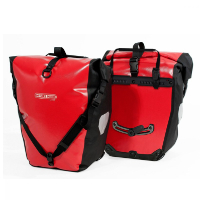
Rear Orlieb panniers x 2
These are super high quality, roll top panniers that are fully waterproof. They come with a removable shoulder strap, which is handy when traveling / carrying the bags. They also have an internal pocket and a zippered mesh pocket for a touch of organisation. At 20 litres each, they hold the bulk of our bike touring gear as follows, between two of us:
Pannier 1: My personal stuff (clothes, toiletries etc), D-lock, snake lock, first aid kit, spare tube
Pannier 2: Rob’s personal stuff (clothes, toiletries etc), electronics
Pannier 3: Sleeping stuff, inner tent
Pannier 4: Food and cooking equipment, tent rainfly, bike cleaning stuff
Frame bags
We each carry a frame bag. Mine (1) fills the whole of my frame which means my water bottle cages are underneath the bike frame and on the front fork. Rob’s bag (2) is smaller (4.2 litres) so he can still hold small bottles inside the frame. Frame bags hold more than you might realise and are excellent for storing things you might need easy access to during the day.
Blackburn Frame bag (1): Toilet kit, spare layer, packable backpack, massage ball, sunscreen, headband, paracetomol, gloves, bike lights, sunglasses case
Restrap Race Frame Bag (2): Spare layer, gloves, electrolytes, snack bars, pump, sunglasses case, buff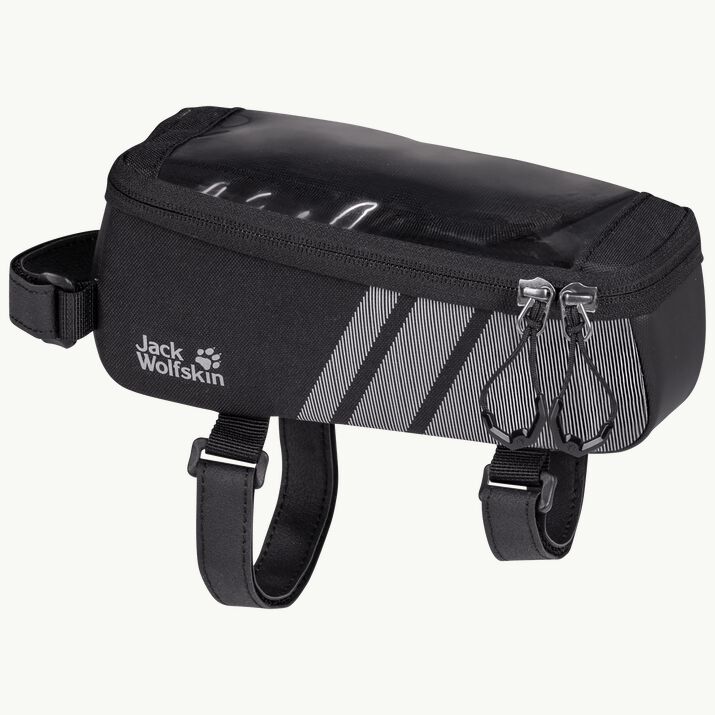
Top tube bags
Again, we each carry a top tube bag but they are very different styles. Mine (1) is long and narrow and runs the length of the top tube offering a 2 litre capacity. Rob’s (2) is short and stout (0.8 litres) and features a window to view a smartphone through. This is actually really useful as a backup navigation system. Top tube bags are ideal for accessing gear on the move or for storing things you’ll need throughout the day.
Restrap Race Top Tube Bag (1): Phone, money, snack bars, peanuts, lip balm, hacky sack, buff
Jack Wolfskin Top Tube Bag (2): Phone, lock keys, snack bars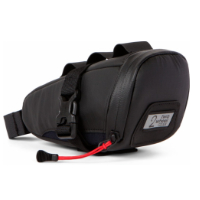
Saddle bag
Rob carries a small saddle bag which is out of the way but easy to access when needed. As his saddle sits higher up than mine, there is plenty of space to have this under the saddle as well as storing things on the top of the pannier rack. Whereas I have no room under my saddle once the pannier rack is loaded up.
Saddle bag: Bike tool, spare tyre, bike levers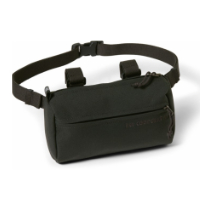
Handlebar bag
We chose a handlbar bag that is easy to remove from the bike and also easy to carry as a bag. This enables us to quickly take it off when we leave our bikes and carry our valuables in it. It has a removable shoulder strap and zippered entry.
Handlebar bag: Bike lights, passports, bag strap, extra space for food storage when needed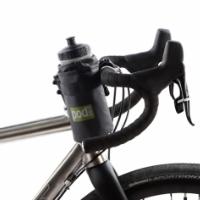
Stem bags
These are genius little bottle holders that fill the space between your handle bars and top tube, making them super accessible when riding. They have drawstring tops to secure them closed on bumpy sections or when it’s raining. And they’re also insulated which somewhat helps keep their contents cool. We both have two each and as well as the below uses, we also use them to cycle short distances with food / beer stored in them.
My pod sacks: Water bottle, camera (easy to grab when you’re riding!)
Rob’s pod sacks: Water bottle, sweets / fruit
Other bike touring bag options include:
- Front panniers
- Fork bags
- Large handlebar bag
- Large saddle / seat bag
- Rack pack
Sleeping equipment
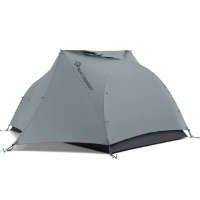
Tent, guy lines, pegs/stakes
A lightweight tent is important for bike touring trips, however, liveability and weatherproofness are more crucial, especially on extended trips. If you are touring with a partner then I highly recommend option for a 3-person tent to give you a bit more space. Unlike backpacking, the extra kilo or so of a bigger tent won’t be a back-breaker when cycle touring and, in my opinion, the extra comfort you’ll gain is well worth it.
Buying tip: Be sure to LOVE your tent. It’s the most expensive item you’ll buy so try a bunch first / do your research to make sure you know what you want.
What we use: Sea to Summit Telos TR3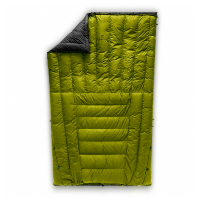
Sleeping bag or quilt
If low weight and warmth is key then opt for a sleeping bag filled with down, which is also super packable. If you’re more likely to be in wet conditions and weight is less important then consider a synthetic sleeping bag.
Buying tip: Sleeping bags come in different sizes. Make sure you choose one that you’ll fit into!
What I use: Zenbivy Quilt
More info: A guide to sleeping bags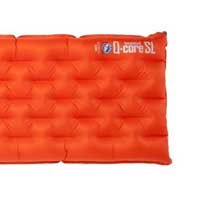
Sleeping pad
This is an invaluable piece of bike touring gear that will make or break your sleep quality. Not only does it provide comfort but it also helps to protect you from the cold ground. There are a few different types of sleeping pads available providing varying levels of comfort and warmth.
Buying tip: For 3-season bike touring look for a sleeping pad with an R-value of 1-3. The higher the value the warmer the pad.
What I use: Big Agnes Q-Core SLX
More info: A guide to sleeping pads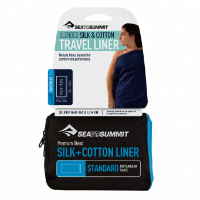
Sleeping bag liner
Sleeping bag liners aren’t for everyone, but we love the ability to wash our bedding easily whilst on the road. This is esepcially important during the summer when the nights are sticky and hot. On the really warm nights we only sleep under our liners and just have our sleeping bag / quilt at the ready in case it cools. Additionally, if you’re touring through variable climates, a liner will add a couple of degrees of warmth to a sleeping bag when it’s cooler.
What I use: Sea to Summit Silk Cotton Travel Liner
More info: A guide to sleeping bag liners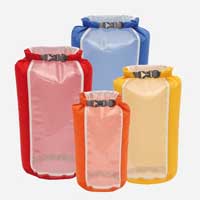
Dry bag to store sleeping bag
Even though it’s packed inside a waterproof pannier, I always pack my sleeping bag inside a dry bag too. As well as protecting it from the weather, it also makes compartmentalising the gear inside your panniers much easier.
Buying tip: A haul handle is useful to drag the dry bag out of your bag more easily.
What I use: Exped Clear Sight Dry Bag
More info: A guide to dry bags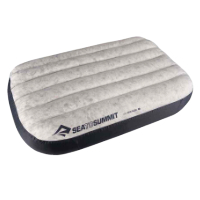
Pillow
The most lightweight and packable camping pillows are inflatable. These are usually better than some folded up clothing, but they’re not for everyone. An alternative is a hybrid camping pillow that combines foam or down with air. Another option is to combine your inflatable pillow with a down jacket, stuffing them both inside a pillowcase.
What I use: Sea to Summit Aeros Down Pillow
More info: A guide to camping pillows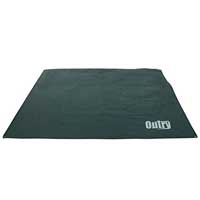
Tent footprint / ground sheet
I highly recommend taking some sort of small tarp on any bike touring trip. They don’t take up much space, aren’t very heavy and are super useful. In dry weather they are ideal for food prep and cooking, acting as a tablecloth for the ground! In wet weather they act as extra shelter. And on rough ground they provide extra protection to the base of the tent when laid out underneath it.
What we use: Outry Waterproof Tarp
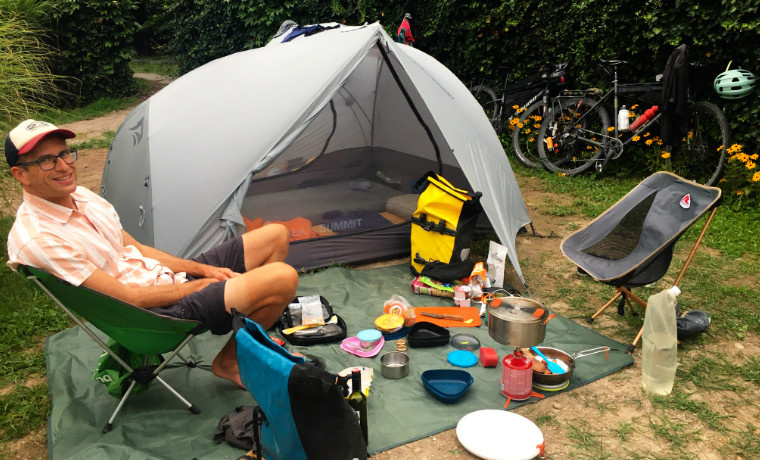
Cooking equipment
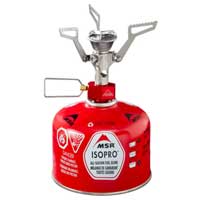
Stove and fuel
There are various options of stoves to choose for bike touring. And what you opt for depends on where you’re touring and the type of fuel that might be available there. In Western Europe and North America, small propane gas canisters are usually easy to get hold of and the stoves they fuel tend to be lightweight, packable and powerful. However, there are also multi-fuel stoves available which will have you covered in most places in terms of fuel availability.
What I use: MSR Pocket Rocket 2
More info: A guide to lightweight stoves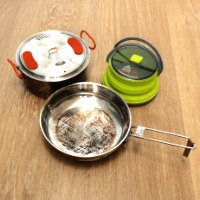
Cookset
Depending on your cooking preferences, cookware can range from single pots – intended for cooking and eating out of, to full mess kits with bowls, cutlery and a couple of pots and pans. If you’re only cooking simple meals then keep your cookware set simple and if your stove and fuel fit inside it, then all the better!
Buying tip: Consider a more substantial cookware set with a variety of options that you can then pick and choose from to suit your trip and party size.
What we use between two: Sea to Summit X-Set 32 collapsible kettle, GSI Glacier Basecamp pot with lid, Primus Campfire frying pan
More info: A guide to cookware for camping and backpacking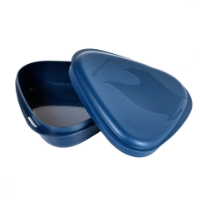
Mess kit / plate and bowl
There are loads of options when it comes to what you eat your food from. As mentioned above, you may be content eating straight out of your cooking pots. But if you’re cooking more comprehensive camp meals then any old camping plate and bowl will be fine. That said, I prefer using a lidded tupperware: the lid is a good sized plate and the tub is ideal as a bowl. This option also offers somewhere to store leftovers the next day, or to leave overnight oats in for breakfast.
What I use: Light My Fire Bowl’n Lid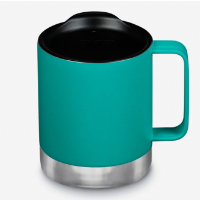
Mug
If the cooking set you choose doesn’t come with a mug then you’ll certainly want to bring one. There are many options available, from insulated to collapsible. The lightweight options tend not to retain heat that well but they’re definite space and weight savers.
What I use: Klean Kanteen Camp Mug
More info: A guide to mugs for camping and backpacking
Knife / multitool
A good knife is a bike touring essential that can also be a lifeline in emergencies. However, for something truly versatile and practical, a multi-tool will come in more handy and will have endless uses for more than just preparing food. However, you may find you need more than one knife, especially if you’re into cooking. We carry three knives!
Buying tip: Opt for a folding knife, for packability, with a lockable blade for safety, if possible.
What I use: Victorinox Climber Pocket Knife, Opinel No 8 (for eating and cooking), Primus CampFire Knife for cooking. Overkill, perhaps?!
More info: A guide to knives for camping and backpacking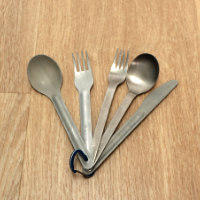
Cutlery and utensils
Some bike tourers need little more than a good old Spork for their camping cuisine. These are just fine if you are eating boil in the bag meals. However, if you are preparing more than spoonable food you may want to consider a set of utensils that you can cook and eat with. Taylor this to your needs, but at the very least I recommend a knife, fork, spoon, spatula or wooden spoon. A small chopping board is also essential. They store easily in panniers and make food prep so much easier.
Buying tip: Folding cutlery is great for packability. But metal utensils aren’t great for food prep and cooking as they can damage non-stick pots.
What we use: MSR and Sea to Summit Lightweight sets, softie spatula, small wooden spoon, teaspoon, GSI Folding Cutting Boards
More info: A guide to camping and backpacking utensils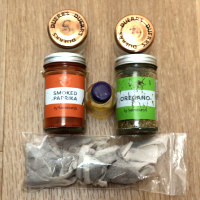
Condiments
We tend to cook all of our evening meals at camp. So we always carry some basic herbs and spices with us. Aside from adding yummy flavours to meals, it also saves some money on buying flavouring packets as you travel (which aren’t always that healthy either!) We also carry tea and coffee for anytime brews, and electrolyte tablets to add to one of our water bottles each day.
What we use: Salt and pepper, smoked paprika, mixed herbs, a small bottle of spray oil.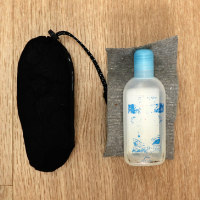
Biodegradable soap, dish cloth and travel towel
Opting for biodegradable soap means minimised the environmental impact of washing up in the wild, if you end up wild camping. Combo it with a small dish cloth or scourer and a quick-drying travel towel to make cleaning up your dishes a breeze.
Buying tip: Opt for an organic liquid soap made with natural ingredients, and a towel that packs down super small.
What I use: Matador Ultralight Travel Towel
More info: A guide to towels for backpacking and camping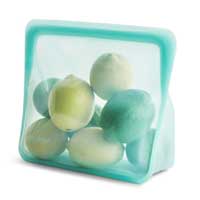
Zip lock bag to store trash
A sealable bag is ideal to prevent moisture and odours from getting into the rest of your stuff. A simple zip lock bag works well. But if you want to use something more substantial then consider a small dry bag or a reusable silicone bag. The other thing to consider is to try using the packaging your food comes is when it’s done. We tend to use large bags of chips etc to put all our trash in and then clip it with a peg if we need to carry it very far.
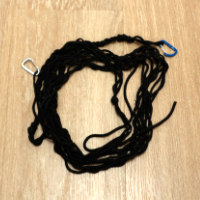
Washing line
This is an easily overlooked essential bit of bike touring gear that you’ll most likely use every day. To save having to bring pegs, use a camping specific clothes line. This is usually a twist of cord or elastic which clothes can be hing from by pushing them between the cord. Attach a couple of mini carabiners on each end to ensure it can be hung easily to a variety of things.
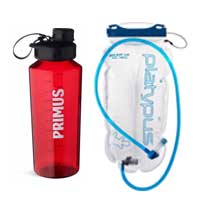
Water bottles and hydration reservoir (3-4 litres in total)
You’ll need to carry at least 3 litres of water per day, or more in hotter climates. Consider whether there will be places to refill throughout the day and also plan to carry more if you’re wild camping and not staying on a campsite.
Buying tip: A collapsible reservoir is ideal as extra water storage during hot and low water sections of your ride. When it’s full, we store ours on top of the pannier rack. Otherwise, it folds up small for easy storage inside a pannier.
What I use: Platypus Big Zip 3 litre Reservoir and two cycling bottles.
More info: A guide to hydration bladders.
Water filter and / or purification tablets
There are loads of filtration and purification systems available for camping. Before you choose one, however, it’s important to understand the availability of water where you’ll be riding, how safe it is and whether you can top up as you go or if you’ll need to fill larger bottles to last for longer.
Buying tip: Consider whether you’re filtering for just you or for your whole party. You’ll also need to understand if there are specific nasties that you’ll need to filter out in the area you’ll be in (heavy metals, pesticides, viruses etc).
What I use: MSR Trailshot Pocket-Sized Water Filter for “just in case” situations, or Lifestraw Universal if it’s to be used regularly.
More info: A guide to water filters
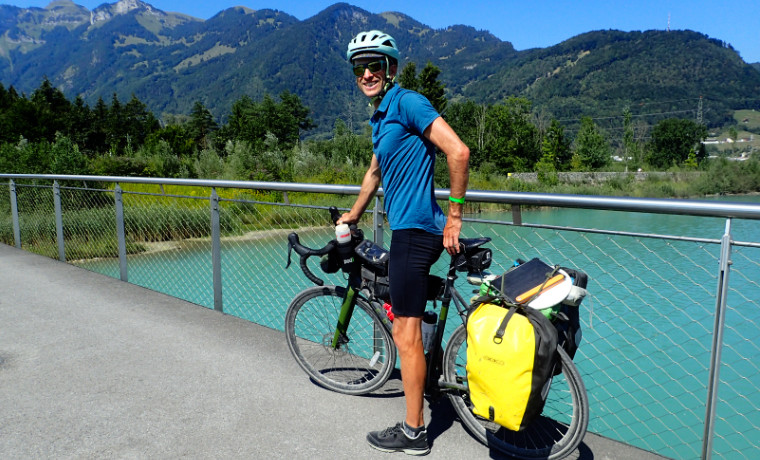
Clothing and footwear for bike touring
The more you go bike touring, the easier it will be to get your clothing and layering systems right. And of course, you’ll constantly need to adjust what you wear and pack depending on the location, trip duration and conditions.
Summer / warm climate bike touring is much easier to pack for than during cooler times of year or in cold climates. As such, if you’re new to bike touring, I highly reccommend taking your first trip in warm conditions. Not only will this make packing much more straight forward, but everything’s just much easier when it’s warm and sunny, not to mention more fun!
Of course, there’s a limit! And prolonged time cycling in extreme heat can be as unfun as in the cold and rain.
Needless to say, the weather won’t be as expected at some point during your bike touring adventure, making the “plan for all weathers” approach, the only one to adopt.
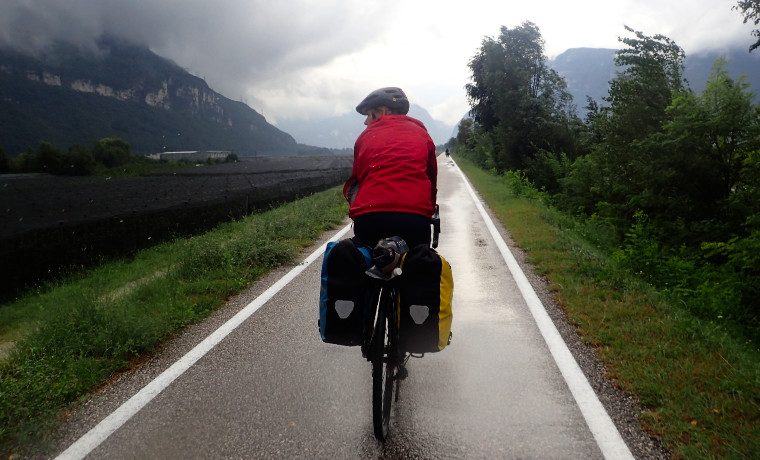
Clothing for summer bike touring
- Shorts to cycle in – this is a very personal thing and something you’ll need to spend some time experimenting with before you embark upon your tour. The options include: padded cycling shorts with or without underwear, normal sports shorts with underwear, padded undershorts (no underwear) with baggy biking shorts over the top, specific touring shorts and baggy biking shorts with built-in pads. Many tourers like to go as casual as possible and avoid tight lycra padded shorts. This also adds a degree of versatility to your cycling wardrobe for the times when you’re not in the saddle.
- T-shirt or vest – any old sports or hiking t-shirt will do fine, so long as it’s comfortable and provides UV protection. That said, cycling specific tops provide extra length at the rear hem and some also have back pockets which can be super useful for storing things, especially when you’re off your bike. If you can afford a merino wool top then I highly recommend investing in one. They’re great at temperature regulation for changeable conditions but best of all, they just don’t get smelly! I only wash my merino vest once a week when touring, and that’s mostly because it’s visibly grubby!
- Long-sleeve top – I wear a high neck merino top with a zipper at the collar. The high neck keeps the breeze out when needed and also protects from the sun. And the zippered allows for venting. The magic of merino (and its lack of stinkiness) means that this is the only long sleeve base layer I take during the summer, doubling as an evening layer too.
- Lightweight pants / leggings – ideally, whatever long pants you choose to pack should be comfortable enough to cycle, sleep and sightsee in. During the summer, you’ll most likely cycle in shorts unless the weather turns very bad. So it’s good to have the option to wear them for all occasions. just in case.
- Waterproof jacket – this is essential for almost all cycling conditions. In general, the more lightweight you go, the less waterproof it will be. But the more heavyweight you go, the less breathable it will be. Getting the right waterproof jacket for cycling touring takes some research. And the level of waterproofness vs breathability vs weight you go for, depends on the climate you’ll be cycling in. There are plenty of cycling specific rain jackets available, but regular waterproof jackets work just fine too.
- Footwear – many bike tourers just wear trainers, walking shoes or sandals when on their bike. Others prefer to wear shoes that attach to their pedals, known as cleats or clip-ins. This comes down to personal preference as well as your past experience wearing cleats. We like to wear cleats, but wear ones with low profile clips on the bottom which make them easier to walk in when you need to. They also have covers that screw over the cleats for prolonged walking. As well as your cycling shoe of choice, it’s a good idea to pack some flip-flops or sandals for time around camp etc.
- Casual wear – it’s likely you’ll pack more casual clothes than you really need, especially if the weather is good and you have access to clean water for washing. My summer bike touring casual wardrobe includes: a mid layer, shorts, t-shirt, vest and a lightweight dress. All of these are suitable for wearing to cycling in, if needed.
- Headwear – many cyclists wear cycling hats underneath their helmet. This can be for warmth but also for sun protection for those with less hair. I go hatless but have a peak on my helmet which is invaluable for sun protection. I then have a lightweight cap to put on when I’m not on my bike.
- Sunglasses – whatever you do, don’t forget your sunglasses! Aside from the protection they give your eyes, life will get pretty uncomfortable for you without them. Plus, everything just looks better through the lenses of a good pair of shades. We love the Smith Chromapop lenses which add an insta-like filter to any scene!
- Gloves – some tourers where gloves all the time, no matter the weather. They can fend off skin rubbing and padded gloves can also help prevent tingling and numbness in your hands. In summer, fingerless gloves can be a good compromise to protect your hands without overheating. I prefer not to wear gloves in the summer. But I still carry a pair for the times when it might be colder like cycling at altitude or early in the mornings.

We try to keep our interaction with the digital world as minimal as possible when we’re bike touring. Of course, this is virtually impossible, especially if you choose to navigate via GPS (which I couldn’t recommend highly enough!). Maps and cycling don’t mix well, and you’ll rinse your phone battery far too quickly if you rely on that for navigation. So, the most important thing is keep your GPS unit battery fully charged.
We use a combination of sources. Our solar panel, which we place on top of the pannier, charges whilst we’re cycling or when we arrive at camp. All of our devices (GPS, phones, headlamp, ipod, bike lights) can be charged directly from this. We also have a battery pack which can be charged via the solar panel as well as the mains when we’re at campsites. If we were wild camping in remote areas for prolonged stretches, a larger, more powerful solar panel would be a good upgrade.
Another essential piece of cycling touring gear is bike lights. It’s easy to think you won’t ever be cycling after dark, and if you do you can just your headlamp. But we used our bike lights loads. Cycling into towns in the evening, on gloomy days, through tunnels and always when we were on busy roads. I have a built in rear light on my helmet, which I find very convenient for the times when you just want a little extra visibility for short sections, and don’t want to (or can’t) stop to turn your main rear light on.
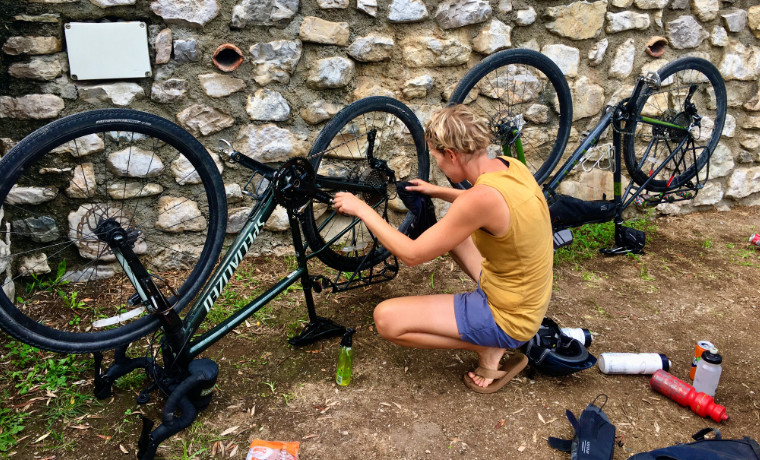
Bike tools and repair kit
Getting into a good bike cleaning routine will greatly affect your cycling efficiency and enjoyment. We try to do a good clean of our bikes every 2-3 days when on the road. The day after a clean and lube feels like you’re riding a new bike! You can get small bottles of degreaser, which are perfect for easy cleaning with an old rag.
Personal items and hygiene
Like clothing, your personal hygiene needs are very specific to you. Some folk carry the bare minimum and go to great lengths to save weight; sawn off toothbrushes and all! Whether you take a full wash bag full of stuff or go feral, is entirely your choice.
That said, the one thing that needs careful consideration is dealing with bathroom stops if you’re cycling in places without access to facilities. To help you manage this, you’ll need a trowel, toilet roll stored in a waterproof bag, a sealable bag to store used toilet paper in and hand sanitiser.
My toilet kit looks like this:
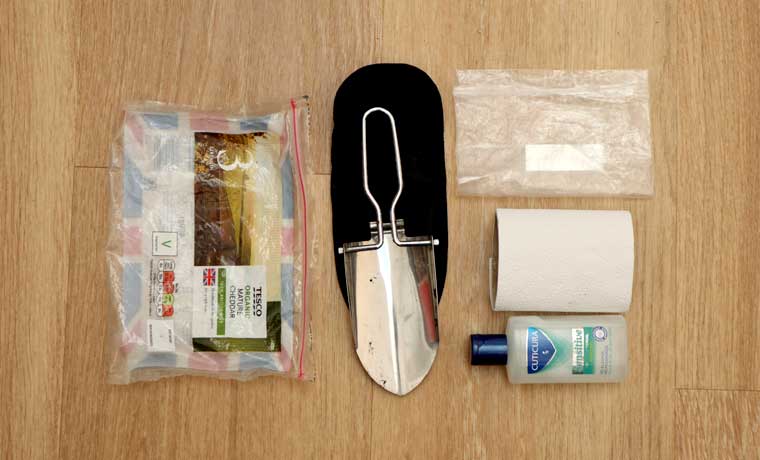
It’s nothing fancy. As you can see I’ve put a cleaned out, resealable cheese packet to good use!
More info: A guide to camping hygiene
I was going to put this on the optional extras section of the bike touring checklist. However, we use our packable backpack so much when touring that we feel it needs to go on the essential items list. Firstly, it makes shopping for and carrying food each day so much easier than trying to find space in your panniers for easily crushable items. Obviously, you don’t want to be cycling miles with a backpack full of fresh fruit and veg! But if you only have a little way to go until your intended camping spot, carrying a backpack is no hardship. Ours also fits nicely on top of the pannier rack, should we need to store extra stuff.
Secondly, a backpack is super useful for on foot day trips. We use ours to cycle into a city carrying our locks and essentials for the day (water, money, guidebook, cards, layers etc.) We use the waterproof Matador Freerain backpack which fits inside my frame bag when packed down.

Optional extras
As with many of the items on this bike touring packing list, the extras you pack will alter as your needs and wants evolve the more trips you take. Our luxury item, which we’ll now never tour without, is a small camping chair each! This came on and off our list multiple times before we did our first tour, finally making the list. And we were very glad it did as we used them every single day. Some days we even busted them out on the road for a luxury trail-side picnic!
Camping chairs are by no means an essential piece of bike touring gear. And many seasoned tourers would most certainly scoff at the idea. But we enjoyed every moment of decadent, laid-back relaxation in them!
We also carry a frisbee! We’re both Ultimate players so we enjoy a warm-up chuck around in the mornings. A frisbees also makes an excellent plate, chopping board and stabiliser for drinks!
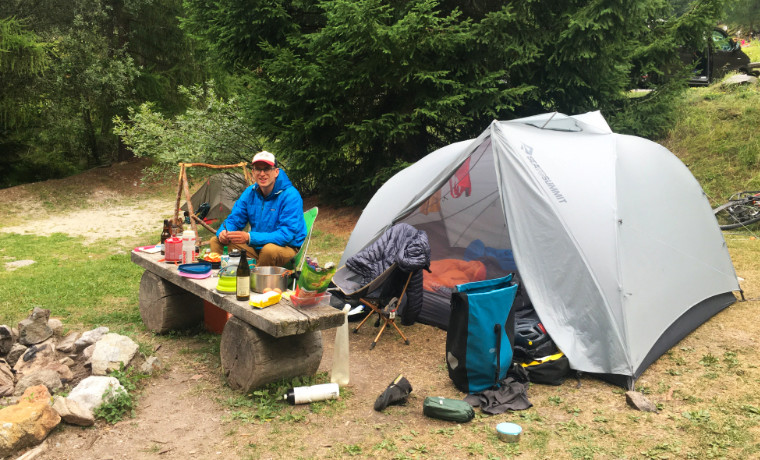
The above bike touring checklist is designed as a guide for beginner bike tourers to ensure you don’t forget to pack the essentials. As mentioned, it will evolve over time and will also be slightly different for each trip. Whatever you choose to pack, understanding the basics of what to take bike touring and how to pack it will help this evolution process and set you on the right track to being fully prepared for extended time on the road.
Happy cycling, happy tourers!
The post Bike Touring Gear Checklist and Packing Guide appeared first on Cool of the Wild.


